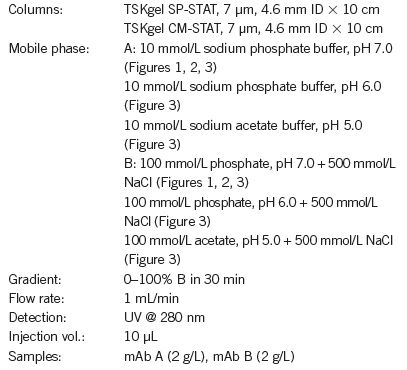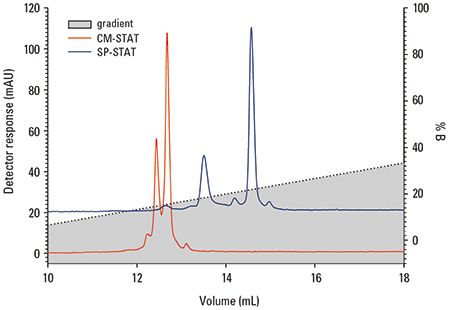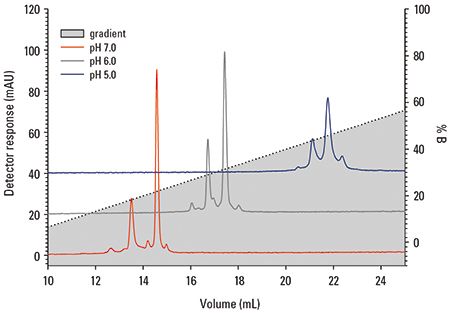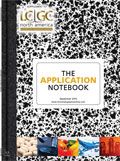Fast Analysis of IgG Charge Heterogeneity by Ion Exchange Chromatography
The Application Notebook
Therapeutic antibodies are enjoying high growth rates in the pharmaceutical market. A majority of the top bestselling global drug brands are monoclonal antibodies (mAbs).
Therapeutic antibodies are enjoying high growth rates in the pharmaceutical market. A majority of the top bestselling global drug brands are monoclonal antibodies (mAbs). The main product characteristics to be analyzed in process monitoring and quality control of these antibodies are aggregation, fragmentation, glycosylation, and charge heterogeneity. Charge isoforms of proteins result from deamidation of asparagine or glutamine residues or from incomplete removal of the C-terminal lysine residue. Besides isoelectric focusing, ion exchange chromatography is the method of choice to analyze charge heterogeneity of proteins.
TSKgel® STAT columns are packed with a non-porous polymer based stationary phase. Proprietary surface modification technology ensures a high density of charged groups. Compared to traditional porous ion exchange phases, non-porous particles yield outstanding resolution of charged species at shorter analysis time. TSKgel STAT columns are available with a weak cation exchanger containing a weak acid (carboxymethyl) and as a strong cation exchanger containing a bonded sulfonic acid group (sulfopropyl). Best performance is achieved when the columns are used with low dead volume chromatography systems, such as modern UHPLC systems. This application note presents the fast analysis of mAb charge heterogeneity by cation exchange chromatography using TSKgel STAT columns.
Experimental Conditions

Results
The charge isoforms of two monoclonal antibodies were separated on a TSKgel CM-STAT weak cation exchange column and a TSKgel SP-STAT strong cation exchange column. Figure 1 shows the analysis of mAb A on both columns at pH 7. For this IgG, the weak cation exchange column delivers a better separation of the basic variant from the main peak.

Figure 1: Analysis of mAb A on weak and strong ion exchange columns at pH 7.
As shown in Figure 2, this is not the case for mAb B, where the strong cation exchange column shows a better separation. Retention and resolution of the charged isoforms are dependent on the buffer pH, as can be seen in Figure 3 for the analysis of mAb B on TSKgel SP-STAT.

Figure 2: Analysis of mAb B on weak and strong ion exchange columns at pH 7.
Conclusions
Weak and strong cation exchange columns provide different selectivities for the analysis of charge heterogeneity of proteins. In order to reach the best separation of acidic and basic isoforms from the main peak, both types should be evaluated at various pH values of the mobile phase during method development. TSKgel STAT series columns provide a high resolution of isoforms in a short analysis time and are ideally suited for the QC of biotherapeutics by UHPLC or HPLC.

Figure 3: Dependence of cation exchange separation on mobile phase pH.
Tosoh Bioscience and TSKgel are registered trademarks of Tosoh Corporation.

Tosoh Bioscience LLC
3604 Horizon Drive, Suite 100, King of Prussia, PA 19406
tel. (484) 805-1219, fax (610) 272-3028
Website: www.tosohbioscience.com

SEC-MALS of Antibody Therapeutics—A Robust Method for In-Depth Sample Characterization
June 1st 2022Monoclonal antibodies (mAbs) are effective therapeutics for cancers, auto-immune diseases, viral infections, and other diseases. Recent developments in antibody therapeutics aim to add more specific binding regions (bi- and multi-specificity) to increase their effectiveness and/or to downsize the molecule to the specific binding regions (for example, scFv or Fab fragment) to achieve better penetration of the tissue. As the molecule gets more complex, the possible high and low molecular weight (H/LMW) impurities become more complex, too. In order to accurately analyze the various species, more advanced detection than ultraviolet (UV) is required to characterize a mAb sample.














